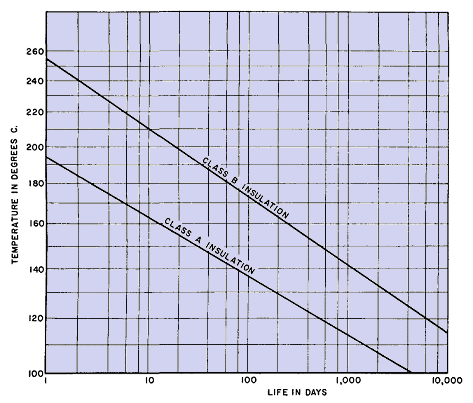| Electronic Transformers and Circuits is a free introductory textbook on transformers and related circuits. See the editorial for more information.... |

|

Home  Transformer Construction, Materials, and Ratings Transformer Construction, Materials, and Ratings  Insulation Insulation |
||||||||||
| See also: Oil Insulation, Windings and Insulation | ||||||||||






|
||||||||||
Insulation
Three classes of insulation are used in dry-type transformers. Class A insulation is organic material such as paper, cotton, silk, varnish, or wire enamel. Class B insulation is mica, asbestos, glass, porcelain, or other inorganic material with organic binders such as varnish for embedding the insulation. A small amount of other class A material is permissible in a class B coil "for structural reasons," but it should be kept to a minimum.
The necessity for small size in aircraft or mobile apparatus is continually increasing the tendency to use materials at their fullest capabilities. As size decreases, the ability of a transformer to radiate a given number of watts loss also decreases. Hence, it operates at higher temperature. Transformers for 400- and 800-cycle power supplies can be made in smaller overall dimensions by using class B insulation (see Section 20). As a result, from 30 to 50 per cent decrease in size (as compared with class A insulation), in addition to increased ability to withstand extremes of ambient temperature, humidity, and altitude, is obtained. Class B insulation is thus of special importance in aircraft apparatus. Usually at 60 cycles enough room is available to use class A insulation, but mica may be used to reduce the size of high-voltage units. A third class of insulation is the silicones, organic silicates with remarkable thermal and mechanical properties. These materials are coming into use at operating temperatures approaching 200°C. Sili-cone-treated cloth, silicone rubber, and silicone varnish are already in use. Under development are silicone wire enamel and silicone-bonded mica. They are generally designated as class H insulation. For apparatus having long service life, AIEE Standard 1 limits the "hottest spot" temperature of impregnated(1) coils as follows:
Class A insulation 105 °C Life test data are plotted in Fig. 36 for class A and class B insulation.
The temperature scale is special, based on T. W. Dakin's data,(2) showing that insulation life is proportional to the reciprocal of absolute temperature. The two lines indicate how operating temperature may be increased for a given life when class B insulation is used. Equal life is obtained when class A insulation is operated at 105°C maximum (40°C ambient, 55°C rise, 10°C hottest spot gradient), and when class B insulation is operated at 130°C maximum (40°C ambient, 80°C rise, 10°C hottest spot gradient). Intermittent load temperatures may be high for short periods. These periods are additive. For example, class A insulation has approximately the same life whether it is operated at 115°C continuously or half the time at 123°C and half the time at 25°C. Figure 36 shows only the influence of temperature on insulation life. Life is further reduced by moisture, vibration, and corona. It is therefore important that insulation be protected against damage caused by all these factors. Such protection is discussed in Section 20.
|
||||||||||
Home  Transformer Construction, Materials, and Ratings Transformer Construction, Materials, and Ratings  Insulation Insulation |
||||||||||
Last Update: 2011-02-17


